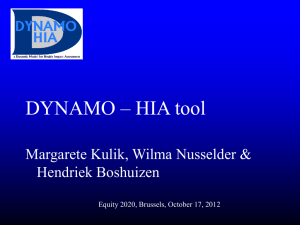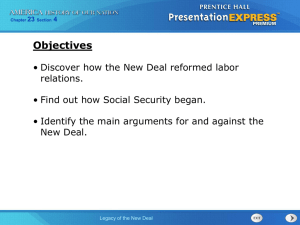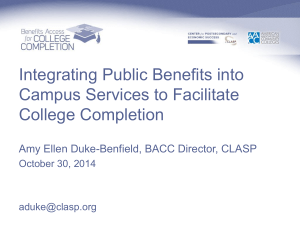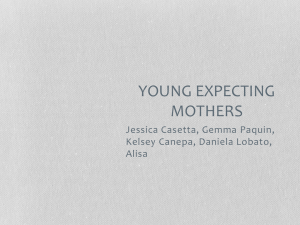Richard Kahlenberg - Wisconsin Scholars Longitudinal Study
advertisement
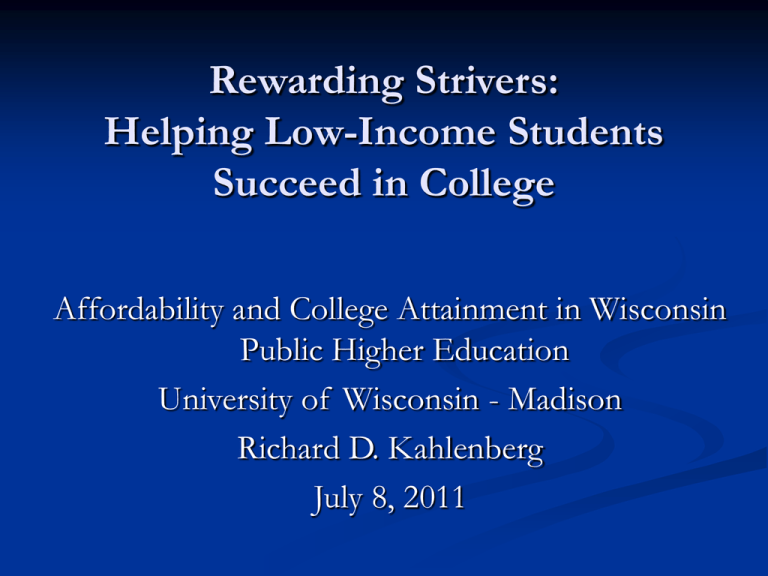
Rewarding Strivers: Helping Low-Income Students Succeed in College Affordability and College Attainment in Wisconsin Public Higher Education University of Wisconsin - Madison Richard D. Kahlenberg July 8, 2011 “Great Equalizer” is Broken Bachelor's Degree Attainment by Age 26 or 29 80% 70% 68% 60% 50% 40% 34.2% 30% 17.2% 20% 9% 10% 0% Wealthy Low-Income Family Socioeconomic Status* White Black Race** *Bachelor’s degree attainment by age 26 for the year 2000. Wealthy refers to students in the top income quartile with at least one parent graduated from college. Low-income refers to students in the bottom income quartile with neither parent graduated from college. **Bachelor’s degree attainment by age 29 for the year 2003. Source: National Education Longitudinal Study 1988/2000 data, cited in William Bowen, Matthew Chingos, and Michael McPherson, Crossing the Finish Line: Completing College at America’s Public Universities (Princeton, NJ: Princeton University Press, 2009), 21, Figure 2.2. Educational Attainment in the United States: 2003, Current Population Report (Washington, D.C.: U.S. Census Bureau, 2003), 5, Figure 3, available at www.census.gov/prod/2004pubs/p20-550.pdf, retrieved August 24, 2010. SES Stratification within Higher Education Socioeconomic Distribution at Colleges by Selectivity, 2006 Bottom SES quartile Third SES quartile Second SES quartile Top SES quartile 8 16 25 19 37 49 Percent 27 83 70 21 17 29 31 29 30 26 25 20 43 17 28 21 14 No postsecondary Community college Less- and noncompetitive Competitive 9 9 8 7 5 Very competitive Highly competitive Most competitive Note: Some columns do not total 100 due to rounding. Source: Anthony P. Carnevale and Jeff Strohl, “How Increasing College Access Is Increasing Inequality, and What to Do about It,” in Rewarding Strivers: Helping Low-Income Students Succeed in College, Richard D. Kahlenberg, ed., (New York: Century Foundation Press, 2010), 137, Figure 3.7. Matters Because Selective Institutions Offer Advantages A. B. C. D. E. Higher Spending Substantial Subsidies Higher Graduation Rates Higher Earnings Greater Chance at Leadership Spending by Selectivity Per-student Spending (in dollars) Per-student Spending at Colleges, by Selectivity, 2006 $100,000 $92,000 $80,000 $60,000 $40,000 $20,000 $12,000 $Least-selective Colleges Most Selective Colleges Note: Selectivity is measured by ranking all colleges according to the national percentile that corresponds with each college’s mean SAT or ACT score. Spending is reported in 2007 dollars. Source: Caroline M. Hoxby, The Changing Selectivity of American Colleges, NBER Working Paper 15446 (Cambridge, MA: National Bureau of Economic Research, 2009), 15. Subsidies Percentage Paid by Student, by Decile 90% 77% Percentage Paid by Student 80% 70% 60% 52% 50% 39% 40% 30% 25% 20% 24% 26% 27% Decile 3 Decile 4 Decile 5 31% 33% Decile 6 Decile 7 20% 10% 0% Top decile Decile 2 Decile 8 Decile 9 Bottom decile Source: Anthony P. Carnevale and Jeff Strohl, “How Increasing College Access Is Increasing Inequality, and What to Do about It,” in Rewarding Strivers: Helping Low-Income Students Succeed in College, Richard D. Kahlenberg, ed., (New York: Century Foundation Press, 2010), 149, Figure 3.17. Calculations based on G. C. Winston, Economic Stratification and Hierarchy in U.S. Colleges and Universities, Discussion Paper 58 (Williamstown, Mass.: Williams Project on the Economics of Higher Education, Williams College, 2000) http://www.williams.edu/wpehe/dps/dp-58.pdf, retrieved November 11, 2009. Higher Graduation Rates Graduation Rates, by Selectivity and SAT-Equivalent Score Tier 1 (highest selectivity) Tier 2 Tier 3 96% 100% Percentage of Initial Attendees Who Graduate 90% 80% 70% Tier 4 (lowest selectivity) 86% 96% 90% 85% 83% 85% 78% 78% 71% 67% 78% 70% 68% 60% 50% 40% 30% 20% 10% Data 0% limitations Data 0% limitations 0% 1000 to 1100 1100-1200 1200-1300 >1300 SAT-Equivalent Score Note: SAT-equivalent scores are based on SAT scores or equivalent percentile correspondences of ACT scores to SAT equivalence. The correspondence was developed by ETS. Source: Anthony P. Carnevale and Jeff Strohl, “How Increasing College Access Is Increasing Inequality, and What to Do about It,” in Rewarding Strivers: Helping Low-Income Students Succeed in College, Richard D. Kahlenberg, ed., (New York: Century Foundation Press, 2010), 151, Table 3.5. Authors’ analysis of survey data from High School and Beyond, U.S. Department of Education, National Center for Education Statistics, http://nces.ed.gov/surveys/hsb/. Higher Earnings Entry-level Earnings of College Graduates, by Selectivity, 1999 $60,000 $53,817 $50,000 $37,081 $40,000 $39,880 $41,779 $33,177 $30,000 $20,000 $10,000 $Community college Less and noncompetitive college Competitive college Very competitive college Most and highly competitive college Note: Dollar amounts are in 2007 dollars. Source: Anthony P. Carnevale and Jeff Strohl, “How Increasing College Access Is Increasing Inequality, and What to Do about It,” in Rewarding Strivers: Helping Low-Income Students Succeed in College, Richard D. Kahlenberg, ed., (New York: Century Foundation Press, 2010), 149, Figure 3.17. Authors’ calculations from Barron’s Selectivity Rankings, various years; National Education Longitudinal Study: Base Year through Fourth Follow-Up, 1988-2000 (Washington, D.C.: U.S. Dept. of Education, National Center for Education Statistics, 2000). Leadership Current Students or Graduates of 12 Elite Institutions as a Percentage of Various Populations 60% 54% 50% Current Students or Graduates of Harvard, Yale, the University of Chicago, Stanford, Columbia, MIT, Cornell, Northwestern, Princeton, Johns Hopkins, the University of Pennsylvania, and Dartmouth Population Share 42% 40% 30% 20% 10% 0.7% 0% Current Undergraduate College Students Government Leaders Corporate Leaders Note: Undergraduate population data for the 12 schools came from each institution’s website. All population counts are for 20092010, except for those from Yale, Cornell, and Northwestern, which are for 2008-2009. Source: Thomas Dye, Who’s Running America? (Upper Saddle River, NJ: Prentice Hall, 2002), 148. Current Population Survey (Washington, D.C.: U.S. Census Bureau and U.S. Bureau of Labor Statistics, 2008), available at http://www.census.gov/population/www/socdemo/school/cps2008.html, retrieved August 24, 2010. Percentage of Students Receiving Pell Grants University of Wisconsin – Madison Ranks Poorly on SES Diversity Percentage of Students Receiving Pell Grants at Selected Public Flagship Universities, 2007 35.0% 33.0% 30.0% 25.0% 20.4% 41st out of 43 flagships 20.0% 13.1% 15.0% 9.5% 10.0% 5.0% 0.0% University of California Berkeley Average for Flagship Universities in 43 States University of Wisconsin Madison University of Virginia - Main Campus Note: Flagships from seven states (CT, KY, LA, NM, NJ, PA, WA) excluded due to problems with data. Source: Kati Haycock, Mary Lynch, and Jennifer Engle, Opportunity Adrift: Our Flagship Universities Are Straying from Their Public Mission (Washington, D.C.: The Education Trust, 2010), 20, Figure 19. UW When Account for State SES Low-Income Student Access Ratio at Selected Public Flagship Universities, 2007 Low-Income Student Access Ratio Low-Income Student Access Ratio = 1.00 0.90 % students receiving Pell grants at institution % students receiving Pell grants in all colleges & universities in the state 0.86 0.80 0.70 0.52 0.60 0.50 30th out of 43 flagships 0.47 __ of __ states 0.40 0.30 0.30 0.20 0.10 0.00 University of California Berkeley Average for Flagship Universities in 43 States University of Wisconsin Madison University of Virginia - Main Campus Note: Flagships from seven states (CT, KY, LA, NM, NJ, PA, WA) excluded due to problems with data. Source: Kati Haycock, Mary Lynch, and Jennifer Engle, Opportunity Adrift: Our Flagship Universities Are Straying from Their Public Mission (Washington, D.C.: The Education Trust, 2010), 20, Figure 19. Good news: Programs to Address Stratification through Financial Aid Schools with Financial Aid Initiatives 90 83 80 Number of Schools 70 60 50 44 40 30 24 20 10 0 2006 2007 2008 Year Note: Number of schools is cumulative. Source: Richard D. Kahlenberg, “Introduction,” and Edward B. Fiske, “The Carolina Covenant,” in Rewarding Strivers: Helping LowIncome Students Succeed in College, Richard D. Kahlenberg, ed., (New York: Century Foundation Press, 2010), 3, 70. Numbers for 2006 and 2007 from “The Politics of Inclusion: Higher Education at a Crossroads—Financial Aid Initiatives,” Updated Conference Materials, University of North Carolina at Chapel Hill, September 2007. Number for 2008 calculated from “New Institutional Initiative to Improve Access for Low to Moderate Income Students,” University of North Carolina at Chapel Hill, updated 5/29/2007, http://www.unc.edu/inclusion/initiatives.pdf, and “Summary of Responses for Updated Inventory of Access Initiatives” [Word document], University of North Carolina at Chapel Hill, updated 11/5/2008. Carolina Covenant Eligibility at 200% of the poverty line (about $44,000 for a family of four) Combination of grants (87%), loans (7%), and work-study (6%) Support programs for Covenant Scholars Faculty and staff mentoring for first-year students Peer mentoring by experienced Covenant Scholars Career guidance and personal development opportunities such as etiquette dinners and career workshops Social events such as pizza parties during pre-exam reading period Not an “affirmative action” program; admissions remain “need-blind” Participation in the program (as of 2009): 1,450 Covenant Scholars were currently enrolled Nearly 1,800 students had participated in the program since its start in fall 2004 Source: Edward B. Fiske, “The Carolina Covenant,” in Rewarding Strivers: Helping Low-Income Students Succeed in College, Richard D. Kahlenberg, ed., (New York: Century Foundation Press, 2010), 28, 34-40, and 46, Figure 2.1. Shirley Ort and Lynn Williford, “Carolina Covenant 2009 Program Update,” University of North Carolina at Chapel Hill, http://www.unc.edu/carolinacovenant/files/2009/Carolina%20Covenant%202009%20Update%20FINAL032509.pdf, retrieved August 23, 2010. Graduation Rates under Carolina Covenant Graduation Rates for Covenant Scholars and Other Students 2003 Control Group 2004 Cohort Percentage Graduated within Eight Semesters 80% + 1.3% 70% + 5.2% 60% 74.3% 75.6% 61.9% 56.7% 50% 40% 30% 20% 10% 0% Covenant All students Source: Edward B. Fiske, “The Carolina Covenant,” in Rewarding Strivers: Helping Low-Income Students Succeed in College, Richard D. Kahlenberg, ed., (New York: Century Foundation Press, 2010), 62, Table 2.8. Data from UNC Office of Scholarship and Student Aid. Overall Pell Percentages Flat Students at UNC Eligible for Pell Grants 16% 14.4% 14.4% 2003-04 2008-09 Percent of Student Body 14% 12% 10% 8% 6% 4% 2% 0% Source: “Pell Grants: The Cornerstone of African-American Higher Education,” special report, Journal of Blacks in Higher Education (Autumn 2009): 74. Three reasons to supplement financial aid with socioeconomic affirmative action Educational. Enhance the university experience. Efficiency. Avoid wasting talent. Equity/Fairness/Justice. Strivers “deserve” to be admitted. Many admissions officers see this rationale as naïve but it appears to resonate powerfully with the public. Wasted Talent among Top Students Postsecondary Destination of Top-scoring Quartile of Students, by Socioeconomic Status 80% High SES 66% 51% 44% Low SES 14% High SES Attended two-year college 24% 21% 24% Low SES High SES 6% Did not attend college 10% 28% 31% Low SES 0% Attended four-year college 10% 20% 30% 40% 50% 60% 70% 80% Percentage of Top-scoring Quartile of Students Source: Anthony P. Carnevale and Jeff Strohl, “How Increasing College Access Is Increasing Inequality, and What to Do about It,” in Rewarding Strivers: Helping Low-Income Students Succeed in College, Richard D. Kahlenberg, ed., (New York: Century Foundation Press, 2010), 155, Figure 3.18. Authors’ calculations of National Education Longitudinal Study data, U.S. Department of Education. Rewarding Strivers: Predicted SAT Predicted Combined Math and Verbal SAT Score, by Type of Student, on a 400-1600 Point Scale 1328 Combined math and verbal SAT score 1400 1200 1054 1000 800 600 544 400 200 0 Highly disadvantaged Average Highly advantaged Source: Anthony P. Carnevale and Jeff Strohl, “How Increasing College Access Is Increasing Inequality, and What to Do about It,” in Rewarding Strivers: Helping Low-Income Students Succeed in College, Richard D. Kahlenberg, ed., (New York: Century Foundation Press, 2010), 173. The Price of SES & Racial Disadvantages The Cost of Disadvantage (in SAT Points), by Category of Disadvantage 56 101 SES beyond individual control Factors within students' constrained choice set 399 Other Race (black) 228 Source: Anthony P. Carnevale and Jeff Strohl, “How Increasing College Access Is Increasing Inequality, and What to Do about It,” in Rewarding Strivers: Helping Low-Income Students Succeed in College, Richard D. Kahlenberg, ed., (New York: Century Foundation Press, 2010), 170, Table 3.7. Economic Affirmative Action: Public Support Support for Racial and Economic Affirmative Action: 3 polls 70 60 50 40 30 20 10 0 65 59 26 LA Times 57 27 EPIC/MRA 26 Race Income Newsweek Source: EPIC/MRA poll (conducted January 29–February 3, 2003); Los Angeles Times poll (conducted January 30– February 2, 2003); and Newsweek poll (conducted January 16–17, 2003). Will Low-Income Students Be Able to Do the Work if they are provided Economic Affirmative Action ? Carnevale and Rose Simulation of Economic Affirmative Action in Top 146 colleges. * Pool consisting of (1) all students who have good grades and score above 1300 on the SAT (or the ACT equivalent), plus (2) economically disadvantaged students with high grades and test scores (between 1000 and 1300 on the SAT). Economic Affirmative Action * Economic disadvantage defined as: (1) being in the bottom 40 percent by socioeconomic status (defined as parents’ income, education, and occupation); and/or (2) attending high schools with a high percentage (>25%) of students eligible for free and reduced price lunch or low percentage (<25%) of seniors going on to four year colleges. * Lottery admissions within this pool of students. * The top 146 colleges represent the most selective 10 percent of four-year colleges and are at the heart of the debate over affirmative action policies. Source: Carnevale and Rose, “Socioeconomic Status,” p. 139. Many Low-Income Students Can Succeed in Selective Colleges Existing Policies vs. Socioeconomic Preferences 100% 90% 90% 86% 80% 70% 60% Percentage of students in the Bottom Two Socioeconomic Status Quartiles Graduation Rates 50% 40% 38% 30% 20% 10% 10% 0% Race-based, legacy, and athletic preferences Socioeconomic preferences Source: Anthony P. Carnevale and Stephen J. Rose, “Socioeconomic Status, Race/Ethnicity, and Selective College Admissions,” in America’s Untapped Resource: Low-Income Students in Higher Education, Richard D. Kahlenberg, ed. (New York: Century Foundation Press, 2004), 142, 149. Socioeconomic Preference Small Percentage points of advantage Adjusted Admissions Advantages at 13 Elite Colleges* 35% 30% 30.2% 27.7% 25% 19.7% 20% 15% 10% 4.1% 5% -1.0% ** 0% -5% Recruited athlete Underrepresented minority Legacy First-generation college student Bottom income quartile *Barnard College, Bowdoin College, Columbia University, Harvard University, Macalester College, Middlebury College, Oberlin College, Princeton University, Smith College, the University of Pennsylvania, the University of Virginia, William College, Yale University ** There is no statistically significant relationship (either positive or negative) between having a family income in the bottom quartile and being admitted. Note: Figures refer to 1995 applicant pool. Adjusted admissions advantage for Bottom income quartile is calculated relative to middle quartiles. Source: William G. Bowen, Martin A. Kurzweil, and Eugene M. Tobin, Equity and Excellence in American Higher Education (Charlottesville, VA: University of Virginia Press, 2005), 105, Table 5.1. Increased Chances of Admissions for Legacies in Three Studies 160 SAT points 1360 1200 Legacy Bonus 19.7 percentage point increase Child of Undergraduate Alumnus: 45.1 percentage point increase 85.1 % Legacy Bonus 59.7 % 40 % Source: Thomas J. Espenshade, Chang Y. Chung, and Joan L. Walling, “Admission Preferences for Minority Students, Athletes, and Legacies at Elite Universities,” Social Science Quarterly 85, no. 5 (December 2004): 1431. Source: William G. Bowen, Martin A. Kurzweil and Eugene M. Tobin, Equity and Excellence in American Higher Education (Charlottesville, Va.: University of Virginia Press, 2005), 105-06. Legacy Bonus 40 % Source: Michael Hurwitz, “The Impact of Legacy Status on Undergraduate Admissions at Elite Colleges and Universities,” Economics of Education Review 30, Issue 3 (June 2011): pp.480-492, and Elyse Ashburn, “At Elite Colleges, Legacy Status May Count More Than Was Previously Thought,” The Chronicle of Higher Education, January 5, 2011, http://chronicle.com/article/Legacys-Advantage-May- Affirmative Action for the Rich: Historical Origins Peter Schmidt’s chapter outlines the rise of legacy preferences after WWI as one way to limit admissions of immigrant students, particularly Jews. Legacy preferences inconsistent with the ideals of a Democratic Republic Michael Lind’s chapter on American experiment in Jeffersonian natural aristocracy vs. Old World’s artificial inherited aristocracy. Carlton Larson’s chapter on U.S. Constitution’s prohibition on granting titles of nobility. Concludes legacy preferences are likely to have been viewed by founders as profoundly unAmerican. Legacy preferences don’t increase alumni giving Surprisingly little research to date. Chad Coffman’s chapter examines top 100 national universities as identified by U.S. News 1998-2008. Those with alumni preferences had higher annual giving ($317 vs. 201) but once control for wealth of alumni, the difference was reduced to $15.39, and was statistically insignificant. Concludes that with appropriate controls, “ there is no statistically significant evidence of a causal relationship between legacy-preference policies and total alumni giving at top universities.” Alumni giving (cont.) 7 institutions dropped legacy preferences during the period of the study and there was “no shortterm measurable reduction in alumni giving as a result of abolishing legacy preferences.” Of top 10 universities in the world in 2008 according to Shanghai University rankings, four (Caltech, UC Berkeley, Oxford and Cambridge) do not employ legacy preference. Under-represented Minority Proportions of National Applicant Pool at 18 National Universities, Legacy Pool, and U.S. Population (2005) 35 33 Percent Minority 30 25 20 15 12.5 10 6.7 5 0 Entire Applicant Pool Legacy Applicant Pool U.S. Population Source: William G. Bowen, Martin A. Kurzweil, and Eugene M. Tobin, Equity and Excellence in American Higher Education (Charlottesville, VA: Univ. of Virginia Press, 2005), 168 (under-represented minority proportion of entire and legacy applicant pools); applicant pool data from all 18 national schools for which authors had legacy data. U.S. Census Bureau, Population Division, Population Estimates Program, Vintage 2005, July 1, 2005 (minority proportion of U.S. population). Challenges for the University of Wisconsin Reduce stratification within the system, drawing more middle-class students into community colleges Supplement financial aid programs with a leg up in admissions for Strivers. Eliminate legacy preferences Contact Information and Sources Richard D. Kahlenberg Senior Fellow The Century Foundation 1333 H Street, NW, 10th Floor Washington, D.C. 20005 202-745-5476 kahlenberg@tcf.org www.tcf.org; www.equaleducation.org Rewarding Strivers: Helping Low-Income Students Succeed in College (New York: Century Foundation Press, 2010), edited by Richard D. Kahlenberg, with chapters by Anthony Carnevale and Jeff Strohl; and Edward B. Fiske Affirmative Action for the Rich: Legacy Preferences in College Admissions (New York: Century Foundation Press, 2010), edited by Richard D. Kahlenberg. America’s Untapped Resource: Low-Income Students in Higher Education (New York: Century Foundation Press, 2004), edited by Richard D. Kahlenberg, with chapters by Anthony Carnevale and Stephen Rose; Michael Timpane and Arthur Hauptman; and Lawrence Gladieux. Richard D. Kahlenberg, The Remedy: Class, Race, and Affirmative Action (New York: Basic Books, 1996). Cost of Disadvantage (in SAT points) 56 Black (compared to white) Non-racial Obstacles: Non-racial Obstacles: 24 Having a dropout sibling 41 No college savings (wealth) relative to having saved $40,000 (per $10,000) 12 Live in the South Neighborhood has few heads of household with graduate education (5 percent versus 90 percent) 113 Majority of school enrollment eligible for free and reduced-price lunch (90 percent versus going to a school with no eligibles) 38 28 Public high school (compared to private) 39 Non-college-going peer group 48 Father is a laborer (compared to being a physician) 43 High school dropout parent (compared to most educated) 13 Lowest income quartile (compared to highest) 0 20 40 60 80 100 120 SAT points Source: Anthony P. Carnevale and Jeff Strohl, “How Increasing College Access Is Increasing Inequality, and What to Do about It,” in Rewarding Strivers: Helping Low-Income Students Succeed in College, Richard D. Kahlenberg, ed., (New York: Century Foundation Press, 2010), 170, Table 3.7.
